Marc Marquez was literally pulling his hair out until Honda turned his season around
Could the 2017 MotoGP contest have been better? Hate to carp, but a couple of prime contenders were knocked out in the second half of the year, with Yamaha’s puzzling mishit. Even so, it left one of the best title fights in memory – two polar opposites locked in combat until the last of 18 races. All the better for being so unexpected.
Marc Marquez quite rightly prevailed, eventually. But he’d started off badly on a once again much-revised Repsol Honda, with an all-new big-bang engine.
A third of the way through, after Mugello’s Italian GP, he was some 37 points adrift of series leader Maverick Viñales, and feeling the heat: “My hairdresser told me I was losing my hair. I said: ‘Impossible. I am only 24. My father, my grandfather, they have hair.’”
His doctor confirmed the barber’s diagnosis of excess tension. He told Marc he had to change his approach.
More encouraging for Marc were the words of crew chief Santi Hernandez, running the long-standing crew he calls “my other family in the paddock”. He told the title defender: “By the summer break, you will be leading on points.” That was only three races away.
Marquez went on a run of second, third and first – his second win of the year at a second anti-clockwise track (Sachsenring), the dirt-track-loving superstar’s favourite way of riding.
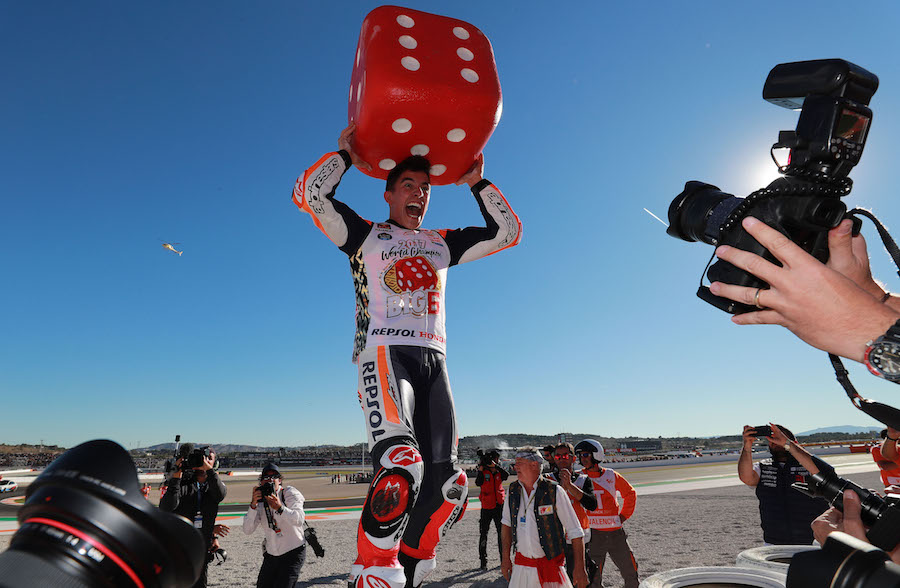
Marquez, Valencia MotoGP 2017
Sure enough, Marquez left Germany five points ahead, and returned for the post-holiday Brno round to take a third win, with a brilliant tactical move. On a drying track, he risked slicks a lap or three before anybody else, and slammed them all.
Marquez had a typical season of surreal adventure with 27 crashes, all but one in practice or qualifying, as he found the limit the way he knows best – by exceeding it. He also accomplished a number of epic saves, picking up the RC213V when any other rider would have given up.
It was a sixth title for the young Spaniard (counting 125 and Moto2), and one with special meaning beyond the prevention of premature hair loss. “Last year I had an early lead and I had to defend it. This year I had to attack until the end.”
Mugello was a turning point for the rider who emerged as his greatest rival.
Andrea Dovizioso had won only two races in nine years of trying, both in the wet. But this year marked five years of patient development by Ducati, focused on lead rider Dovi, the last four years with clever-clogs engineer and strategist Gigi Dall’Igna, poached from Aprilia to rescue Ducati from its post-Rossi slump. (Rossi’s return to Yamaha, ironically, had scotched Dovi’s expectations of going there after a strong 2012 on the independent Tech 3 Yamaha.)
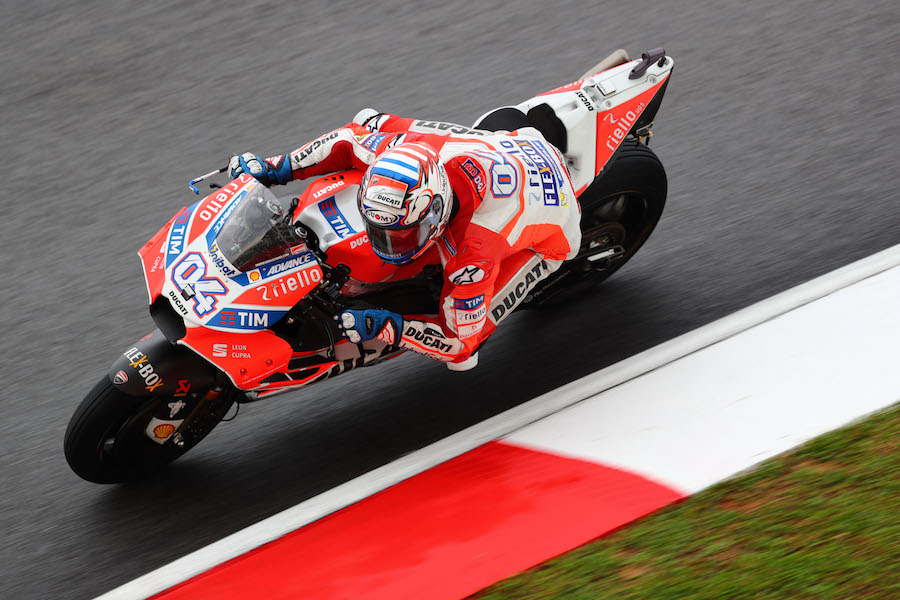
Dovizioso, Malaysian MotoGP 2017
A change of spec for the front tyre (riders voted for a harder-construction Michelin after the first five races) and a new revised-flex chassis gave the 31-year-old a dream ticket for his home GP, and he scored a brilliant first dry win. He followed it with another in the next race at Catalunya and his challenge was up and running.
Dovi would equal Marquez with six wins in 2017. Two were truly memorable.
In the dry in Austria and in streaming wet at Motegi the pair duked it out, and each time at the last corner Marquez made a mad lunge up the inside.
The Dovi of old would probably have let him go and settled for second. But working with cult Italian psychologist Amedeo Maffei had taught him something new – not to race against other riders, but to concentrate on achieving his own best. Dovi cleverly watched him slip past, then cut back on the exit to lead over the line.
In the end, it wasn’t enough for Dovi. A dismal 13th at Phillip Island was his worst finish of the year, and at a crucial time.
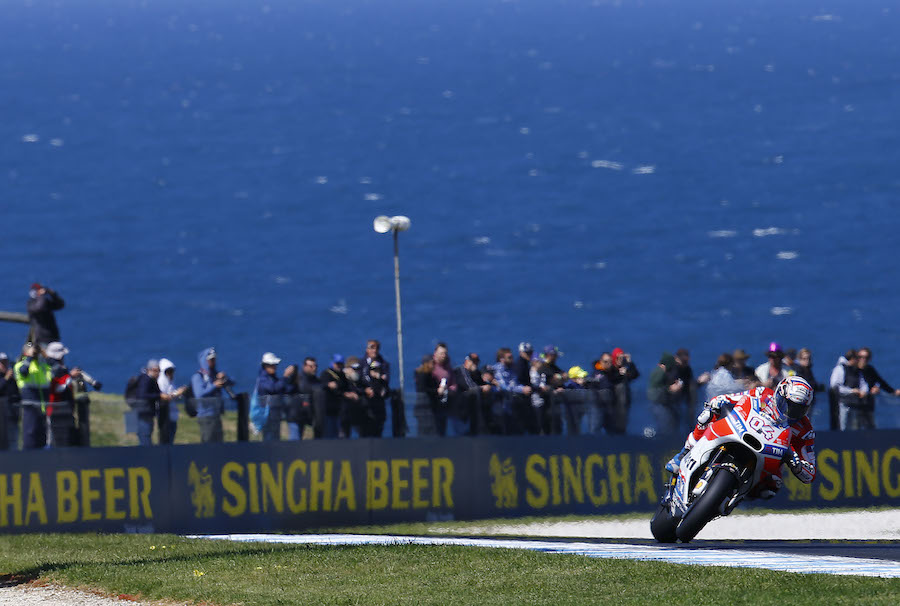
Dovizioso, Australian MotoGP 2017
And at that point Marquez was gaining strength. But for dropping a valve at Silverstone – incredibly, Honda’s first race blow-up since Hayden’s at Phillip Island in 2007 – he’d have tied up the title one race early.
The Yamaha puzzle didn’t just affect the fans and pundits, pretty much all of whom had anointed new Movistar teamster Viñales as title winner even before he’d won three of the first five races. He’d quite dominated all the pre-season tests and kicked off at Qatar flying, and again in Argentina. Fourth at Jerez didn’t seem overly important when he won again at Le Mans, pressuring Rossi into a last-lap blunder. But the writing was on the wall, and he would not win again.
One turning point affected everyone, but especially Viñales – the new harder-construction front Michelin, arriving from round six. This allowed braking deeper into the corner, but Viñales’ style is different; he gets the braking done then takes a high corner speed. He was still fast, but his advantage had suddenly gone.
Still, it was more complex than that. Yamaha lost its way with the 2017 bike.
Team-mate Valentino Rossi (one of the prime movers for the harder front) had been suffering different difficulties, but both of them had serious trouble in low-grip situations, whether in the wet or on polished old surfaces like Jerez, where Rossi was tenth. That was his worst finish; Maverick’s was a disheartened 12th at the last round in Valencia.
Rossi was fifth in the final round and lost fourth in the championship to race winner Pedrosa by two points. It was Valentino’s worst position since he was sixth in 2012 on the Ducati.
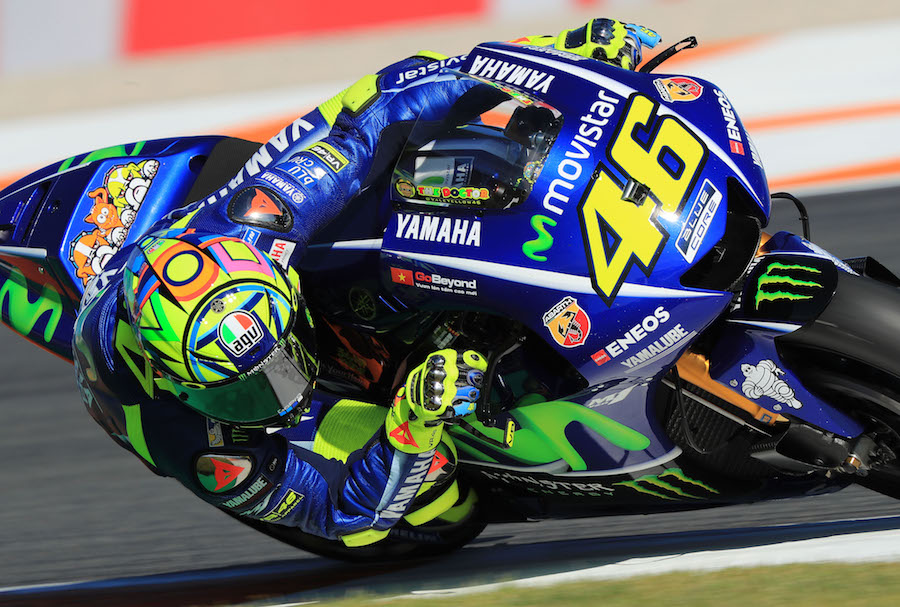
Rossi, Valencia MotoGP 2017
However, Rossi famously had other problems – two dirt-bike crashes, each before a home race. He came to Mugello below par with chest injuries and missed Misano altogether after a double lower right leg fracture. He came back in 23 days, a new record, at Aragon, and opined later in the year that “the Yamaha problems cost me more for the championship than breaking my leg”.
Nebulous though the problems were, they were vividly highlighted by the prowess of wonder rookie Johann Zarco, on a 2016 M-1 for the satellite Monster Yamaha team.
The first-ever double Moto2 champ bookended the year with all guns blazing, leading the first and last races. He crashed in the first but in the last finished second, repeating his home-race Le Mans position, one of three times on the rostrum.
Sixth overall behind Rossi, the 27-year-old Frenchman was massively rookie of the year, top independent team rider, and several times beat the factory bikes.
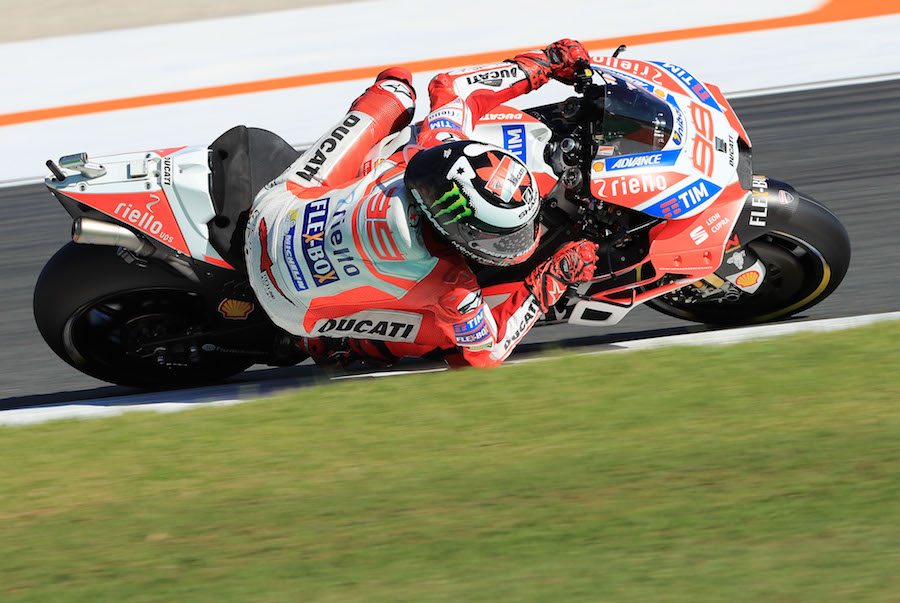
Lorenzo, Valencia MotoGP 2017
The other point of interest was Lorenzo, who aped Rossi’s 2011 move from Yamaha to Ducati, but with rather better timing. The huge differences in the bikes gave him a lot to learn (“like a new language”) and he wasn’t going to do it overnight.
One new technique required was extensive use of a thumb-operated rear brake, used with the throttle open to tighten cornering line and for wheelie control. Never needed that on the Yamaha.
Jorge led a number of races, growing significantly stronger as the year progressed, and was three times on the podium, with a best of second at Sepang. But it was his first season without a win since 2005, his 250 debut year. He was seventh overall.
Independent teamster Danilo Petrucci (Octo Pramac Ducati) produced several highlights, leading twice in the wet, denied each time on the last lap, and added two more podiums. Only one (Mugello) was in the dry, and he was otherwise too often erratic, with a career-worst 13th at Valencia.
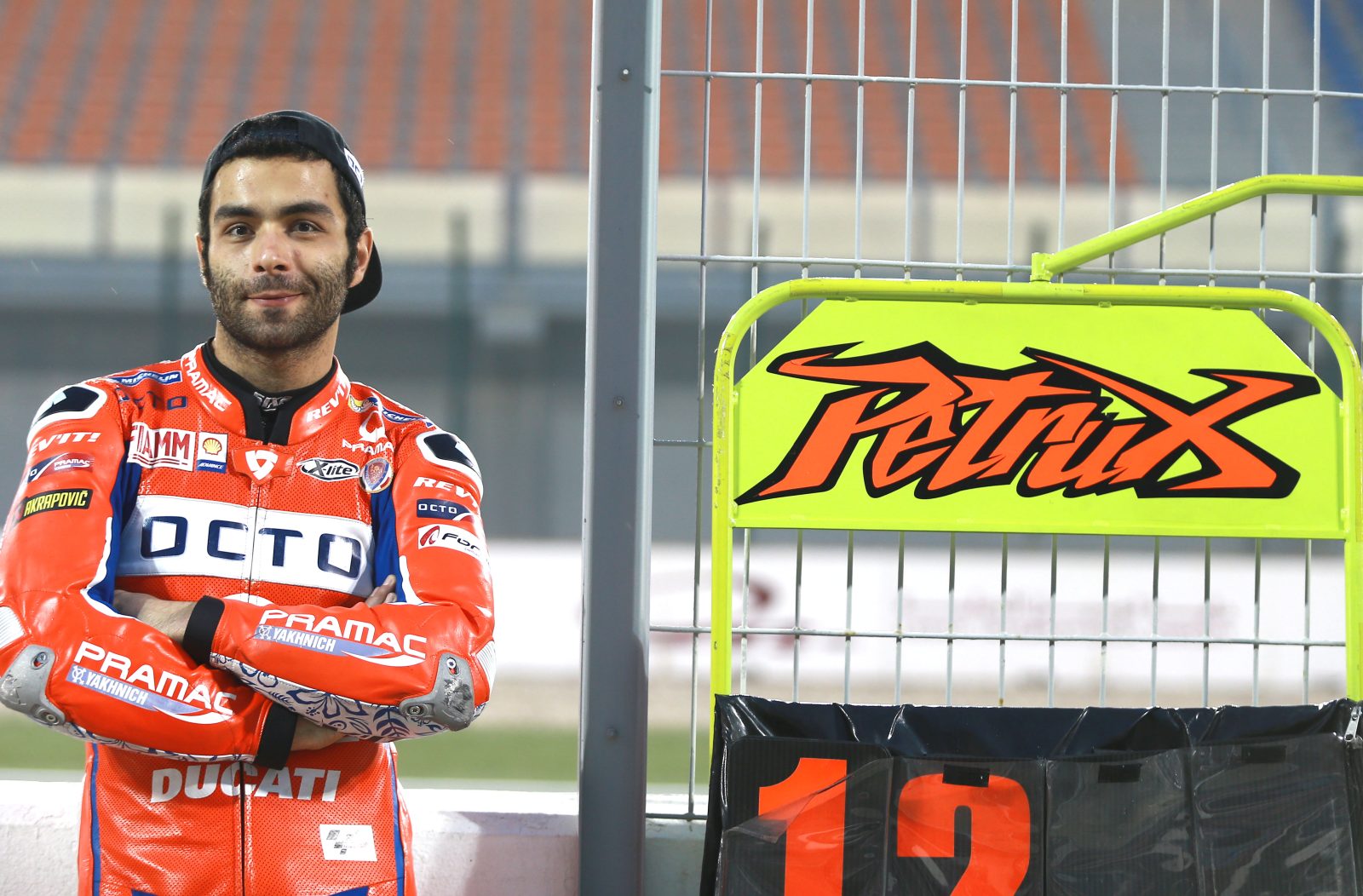
Petrucci, Qatar MotoGP test, March 2017
Other independents had their ups and downs.
Honda’s big-bang firing intervals for the reverse-crank engine introduced last year proved to be something of a handful.
Cal Crutchlow managed just one podium after two wins last year, and was ninth overall on the LCR bike.
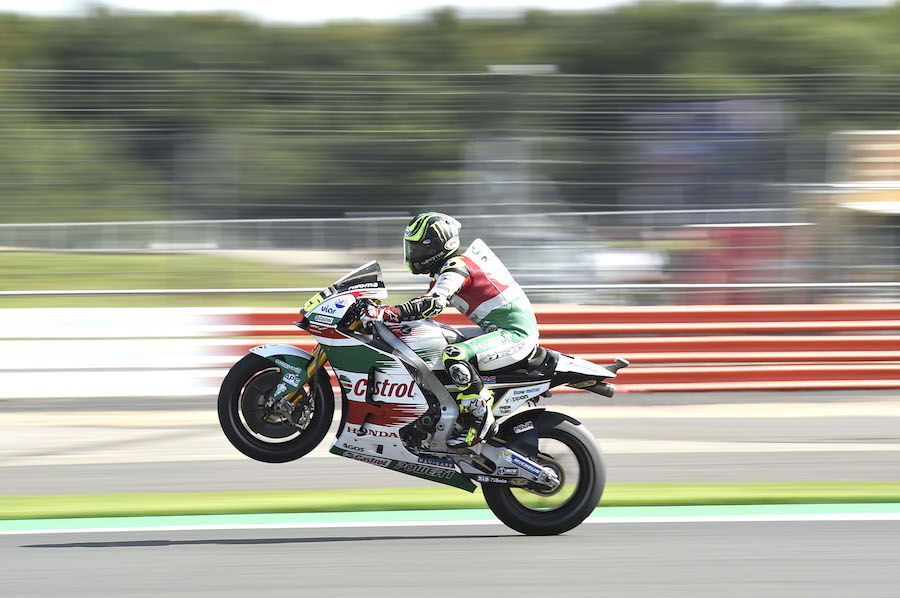
Crutchlow, British MotoGP 2017
Jack Miller missed tenth spot by just two points after a colourful and varied final season riding the VDS Honda before he goes to Pramac Ducati next year.
The Aussie started out with a run of top tens, survived a huge bash into the barriers at Le Mans, then had a patch of poor form before breaking his leg training at home. Jack shaved another two days off Rossi’s return record to start his home GP, led several early laps at Phillip Island, and was still with the front guys for the first of three successive top-eight finishes to close out the season.
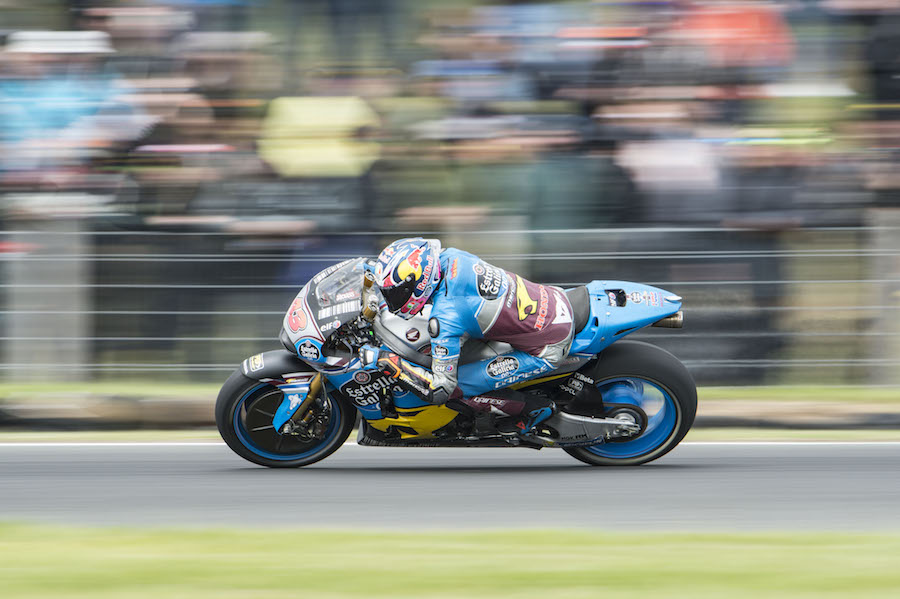
Miller, Australian MotoGP 2017
Tenth went to class rookie Jonas Folger (Monster Yamaha). The highlight was second place after leading his home German GP, but then he missed the last four races with a hard-to-track liver condition.
Another high spot was the arrival of KTM, eventually stealing fifth from Aprilia in the constructors championship (behind Honda, Yamaha, Ducati and Suzuki) with a highly impressive first season, including top-ten finishes, cast-iron reliability, and an independent streak shown by their exclusive use of White Power suspension and a steel-tube lattice chassis instead of the universal aluminium beam.
But the better of the two riders (Pol Espargaro and Bradley Smith) was beaten in the championship by his older brother Aleix, who had some strong races, several blow-ups and lots of crashes on the Aprilia.
That leaves Suzuki, which had a bad year that finally got better after some hefty upgrades – though far too late for new recruits Andrea Iannone (13th) and rookie Alex Rins (16th). Iannone was all at sea trying to adapt his aggressive style to the smooth Suzuki, while Rins suffered a hatful of early injuries but at the last race beat his experienced team-mate (and Rossi) for a fine fourth place.
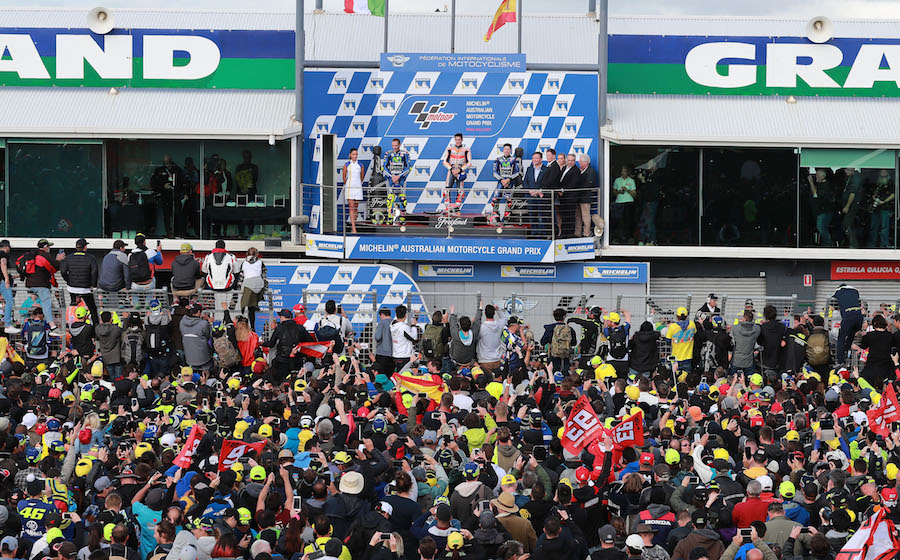
Rossi, Marquez, Vinales, Australian MotoGP 2017
Read Moto2 Wrap: http://amcn.com.au/editorial/24255/
Read Moto3 Wrap http://amcn.com.au/editorial/moto3-2017-season-wrap/